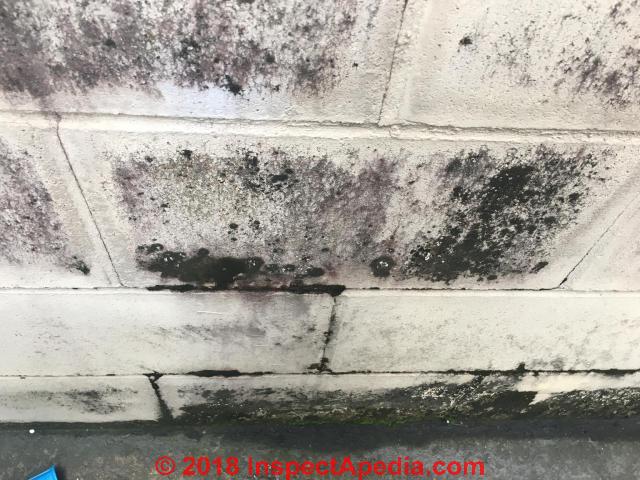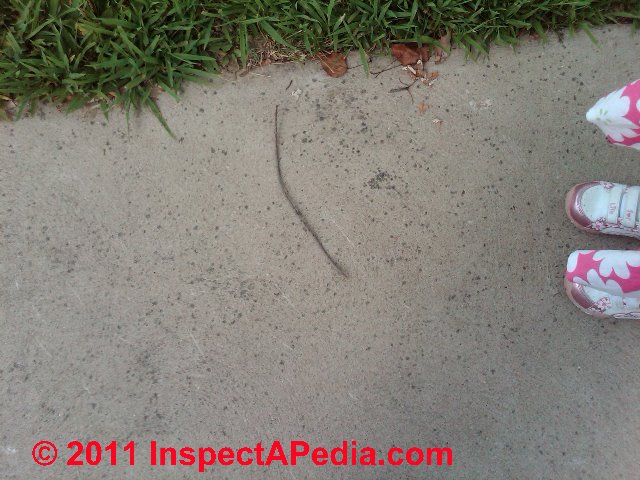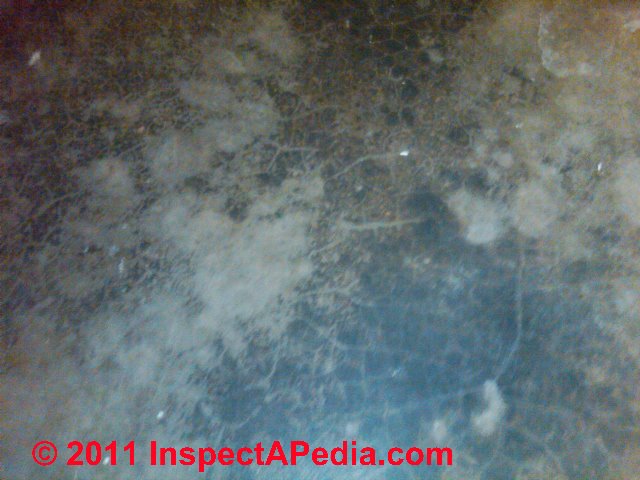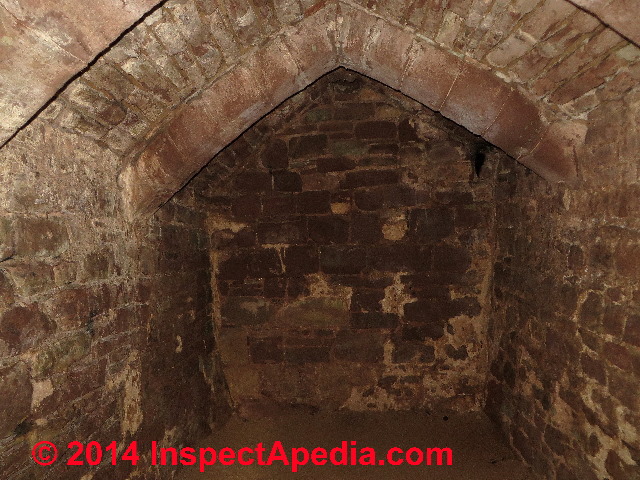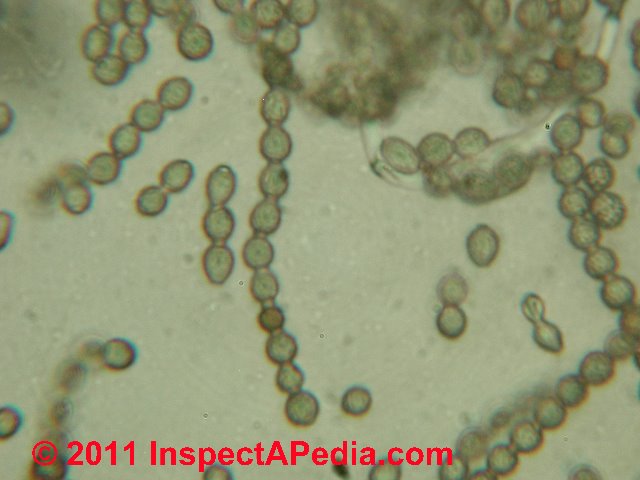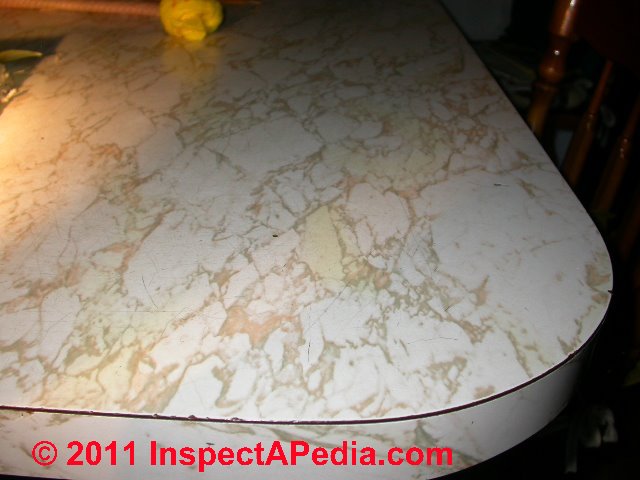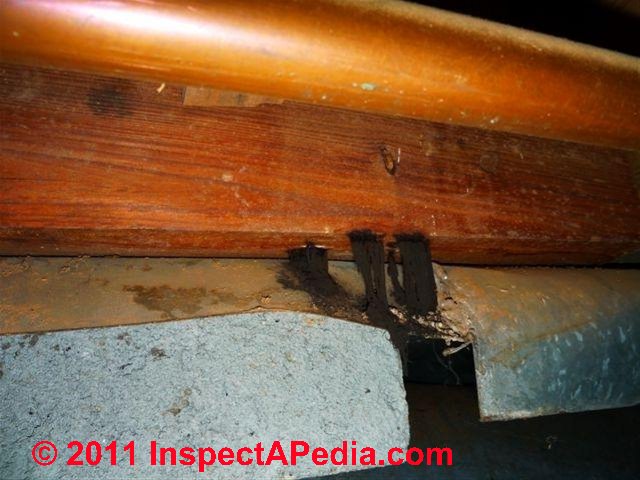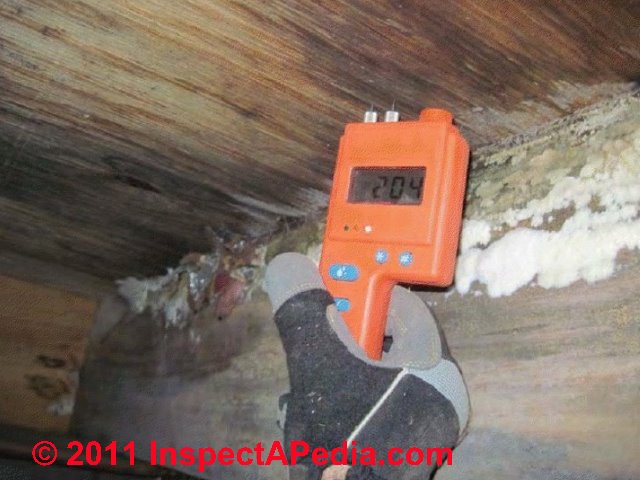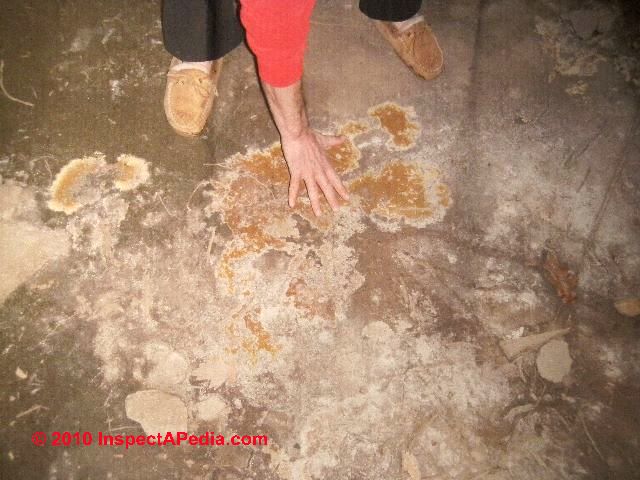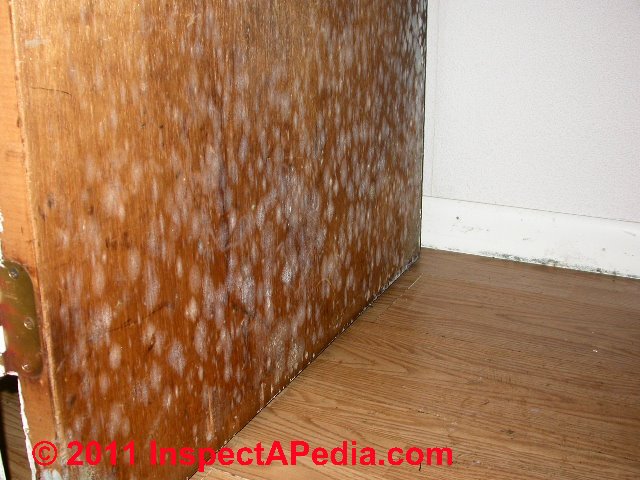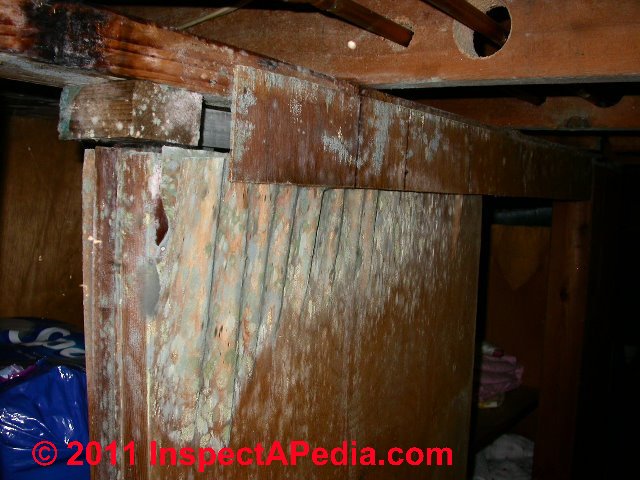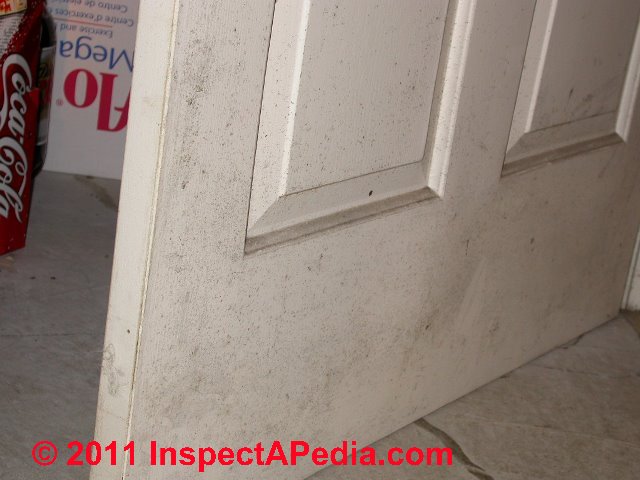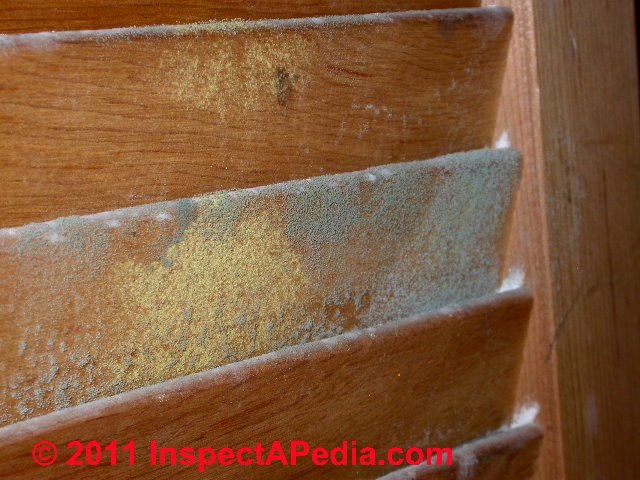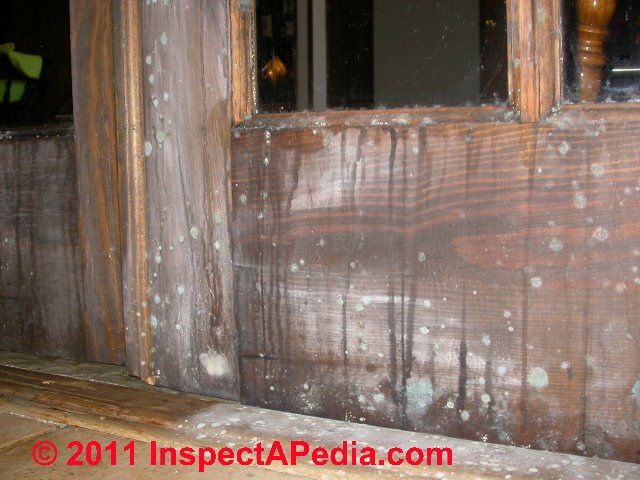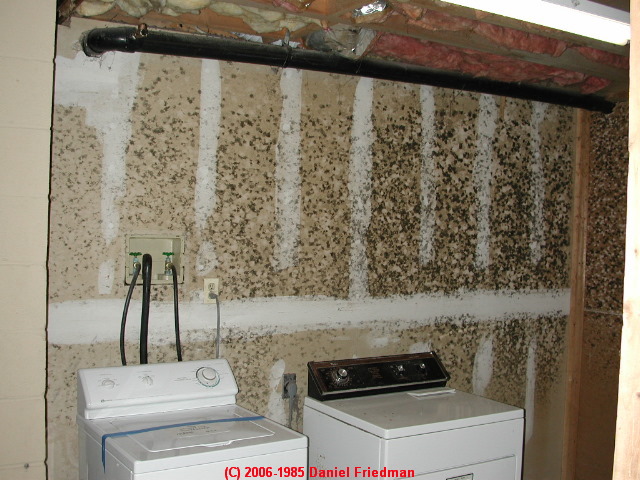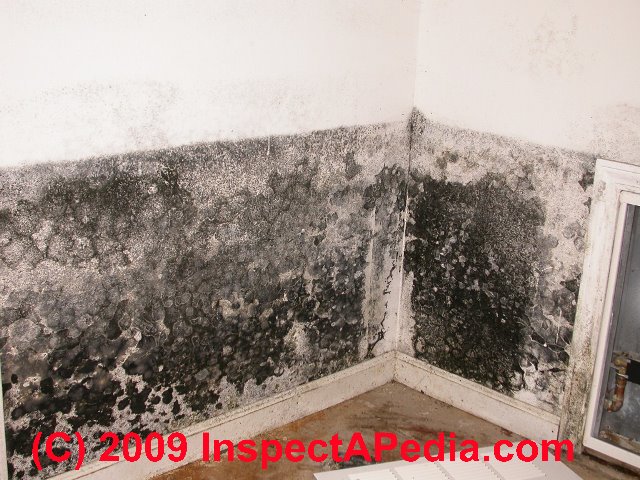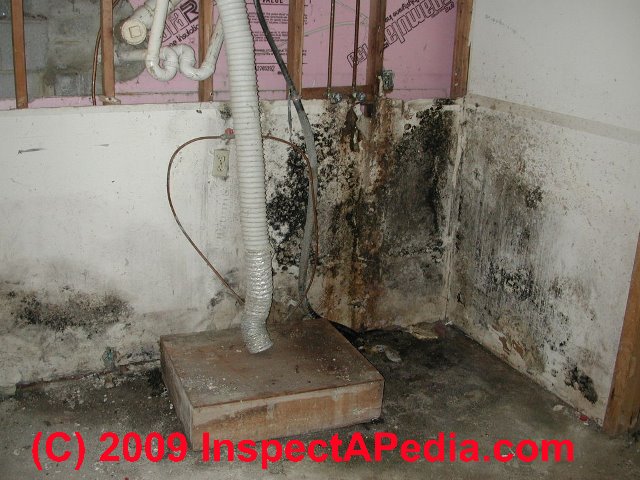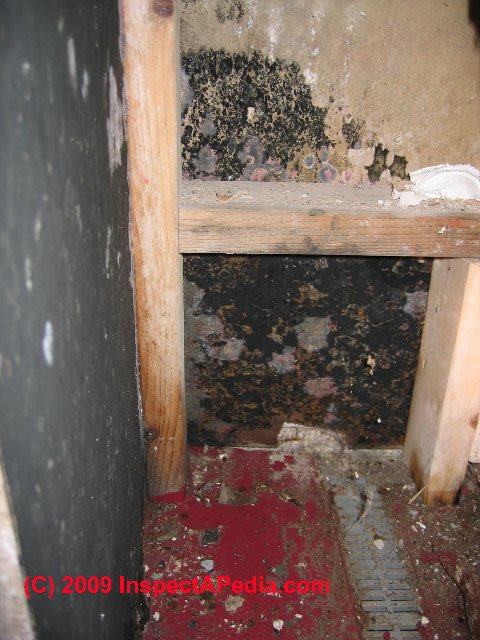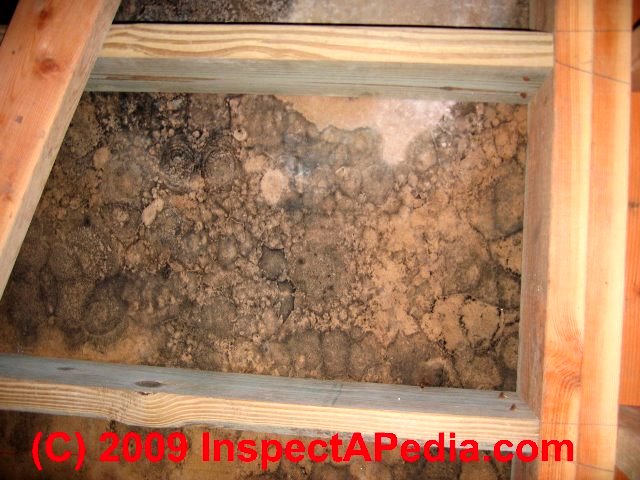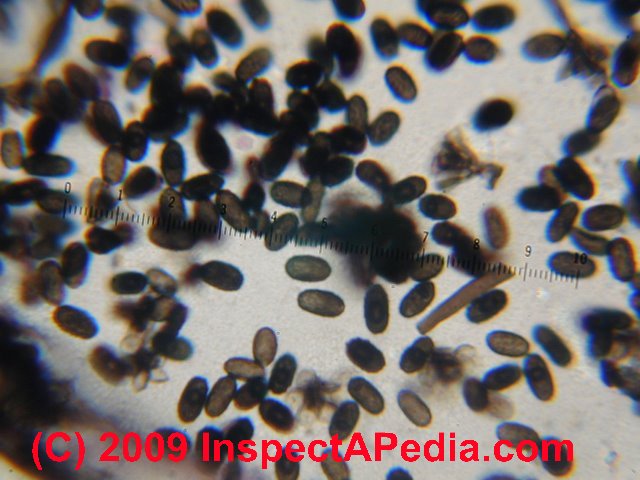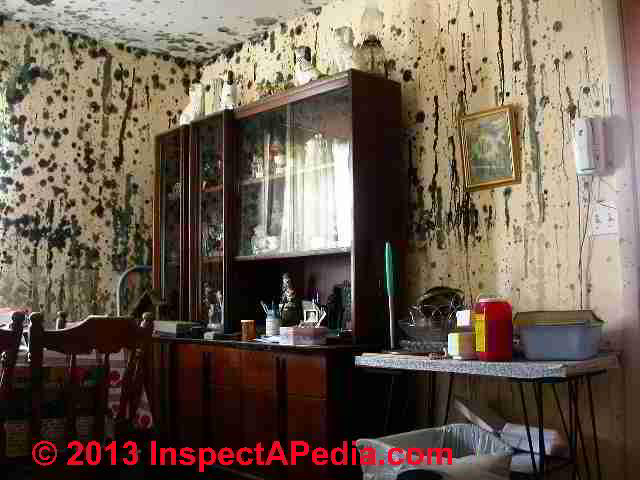 Mold In-Situ: Photos of Mold on Surfaces - Group 4
Mold In-Situ: Photos of Mold on Surfaces - Group 4
Appearance of Mold on Different Materials & Surfaces.
- POST a QUESTION or COMMENT about what mold looks like in buildings, including mobile homes and trailers
Photographs of mold growth in buildings:
Here is an extensive photo guide to mold growth on drywall or sheetrock, mold on computers, moldy concrete, mold on condensed milk, mold on copper piping, mold on countertops, mold on crawl space surfaces, mold on dirt, mold on doors of all types.
What does mold look like growing on various building & other material surfaces? An online reference photo library of various kinds of mold as it is found growing on a wide range of surfaces and materials found on or in buildings.
InspectAPedia tolerates no conflicts of interest. We have no relationship with advertisers, products, or services discussed at this website.
- Daniel Friedman, Publisher/Editor/Author - See WHO ARE WE?
Pictures of Mold on Various Building Surfaces and Materials
Here we illustrate what mold looks like on various building surfaces & materials as well as on items often found in buildings. For page loading speed we have divided this article into several sections.
A photographic guide to the appearance of mold as it is found growing on more than 100 indoor building surfaces and materials such as building contents, furnishings, trim, walls, wood, and personal or even plastic items found in buildings. Mold on drywall or "sheetrock". Mold on computers, moldy concrete, mold on condensed milk, mold on copper piping, mold on countertops, mold on crawl space surfaces, mold on dirt, mold on doors of all types.
Use the link
MOLD APPEARANCE on VARIOUS SURFACES - INDEX
to return to the index / list of photographs of the appearance of mold on various building materials & contents.
--- MOLD GROWTH on MATERIAL SURFACES PHOTOS GROUP 4 ---
- MOLD on COMPUTERS & Electronic Equipment
- MOLD on CONCRETE BLOCK - walls and foundations, painted or un-painted
- MOLD on CONCRETE, STONE, or MASONRY Surfaces
- MOLD on CONDENSED MILK
- MOLD on COPPER PIPES
- MOLD on COUNTERTOPS & counter undersides
- MOLD on /in CRAWL SPACE FRAMING & Subfloors
- MOLD on DIRT SURFACES e.g. in crawl spaces
- MOLD on DOORS, INTERIOR, HOLLOW-CORE
- MOLD on DOORS, INTERIOR, SOLID WOOD
- MOLD on DRYWALL & SHEETROCK®
Photographs of mould found on the surface of items, materials, & surfaces found indoors
[Click to enlarge any image]
Mold on Computers & Electronic Equipment
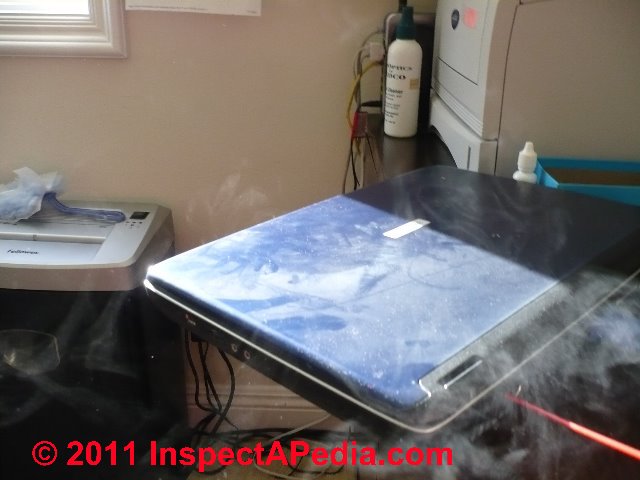
This photograph illustrates mold growth and dust on and from a laptop computer was contributed by a reader.
Mold Growth on Concrete Block, Masonry Block, "Cinderblock"
Photo above: heavy black mold on a concrete foundation wall viewed in the basement of a home, contributed by reader Reese in a Q&A discussed at MOLD APPEARANCE FAQs-3.
While there are genera and species of mold that can grow on just about anything, on a concrete block foundation wall mold is more-likley to grow on a mold-friendly paint on the concrete block surface than on clean un-painted block.
I also find mold growth on organic dust and debris that have collected on the surface of old concrete blocks even when left un-painted.
In all of these cases the gating factor in mold growth is the presence of moisture or water.
Mold on Concrete, Stone, or Masonry Surfaces
Above: a yellow mushroom growing out of a concrete foundation wall in a damp basement. Mushrooms are the fruiting body of many mold genera/species.
Mold or mushrooms growing "on" concrete surfaces such as floors or foundation walls are probably the result of mold growth on organic dust, debris, or paint on those surfaces. Raw, clean concrete is not particularly hospitable to mold growth.
Above we see yellow mushroom type mold growt on a wet concrete floor at the intersection with the wall trim and wall covering - contributed by reader [Anonymous] 2016/08/25 by private email. For this condition we recommended
... looking further for mold growth behind that baseboard trim in your photo, and more important, if the red wall is covered with drywall, I'd be looking for mold behind the trim and on the cavity side or hidden side of the drywall, paneling or whatever covers that wall.
Remove and dispose of wet moldy drywall and any wet insulation behind it. Clean the wall cavity and let it dry before repair.
And of course, finding and fixing the water source.
In other words, mold growth is generally associated with organic materials that provide food for the fungi that grow on surfaces.
Photo: contributed by reader Scott and discussed
at MOLD APPEARANCE - WHAT MOLD LOOKS LIKE
we think this is black or dark brown mold growing on a concrete foundation wall. Click to enlarge the photo and you may see light coloured mould growing on the nearby wood surfaces, bolstering that argument.
There are however fungi (and algae) that colonize stone and other masonry materials such as a sidewalk (below left). But in buildings where there is fungal growth on a masonry surface, most often we encounter it on painted surfaces and in our OPINION it is the paint that is providing mold food.
Also on occasion we have found mold growth on bare concrete and concrete block where we suspect that the nourishment for the fungal colony was in part formed by organic dust and debris on the surface (dogs in the basement) or by materials carried to the concrete block surface by outside water seepage.
The photo below illustrates mold or algal growth (probably both) on a stone and masonry surface - black and brown stains on brick and stone of the dungeon at Goodrich Castle, Ross on Wye, in England.
See YELLOW MOLD PHOTOS for other photos of yellow mushrooms (the fruiting body of mold) growing out of concrete surfaces.
See STAINS on STONE, STUCCO DIAGNOSE & CURE for advice.
Mold on Sweetened Condensed Milk
While food products with a very high sugar level are resistant to mold growth, they are not "mold proof" as this case study demonstrated. We left a container of sweetened condensed milk with the can opened but a plastic cover in place for four months.
You can see the results below. This mold growth is not peculiar to the individual sweetened condensed milk brand; rather it could happen with any similar product.
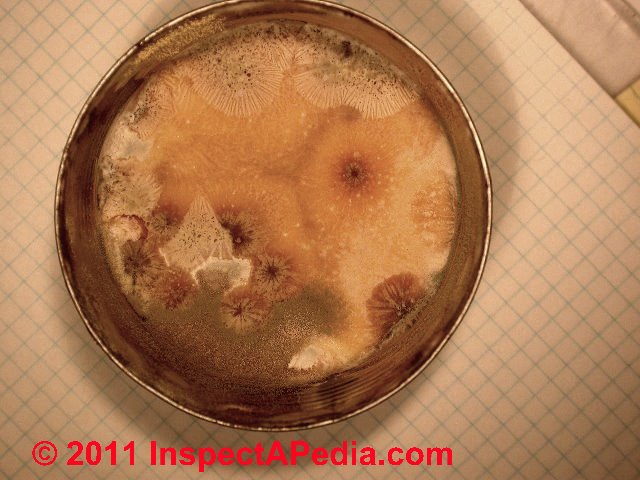
Below we include photographs one of several principal molds that were growing on this sweetened condensed milk product surface - Aspergillus sp.
and long Aspergillus sp spore chains:
Mold vs. Corrosion on Copper Piping
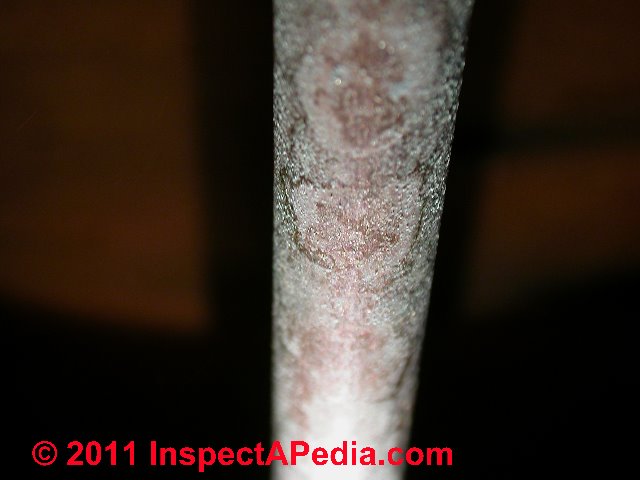
This photograph illustrates how difficult it might be to distinguish between corrosion (expected to be found on copper piping exposed to moisture or corrosive conditions), and fungal growth.
If a lab test found growing mold on this surface we suspect it would be due to the presence of organic dust and debris.
Mold on Countertops and Laminate Counter Undersides
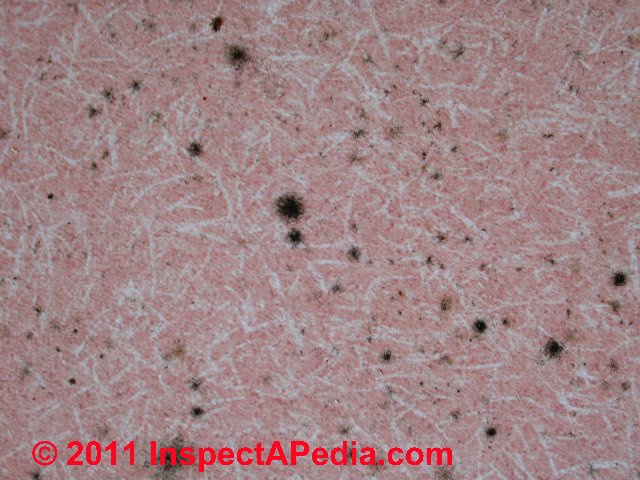
This photograph illustrates mold growth on a plastic laminate countertop in a home that had been flooded and left wet for weeks or longer.
As you can see in our photos, a plastic laminate countertop may appear to be perfectly clean, but its wooden or composition wood or OSB or chipboard substrate may be a welcome host to mold growth in a wet or flooded home.
Watch out: the moldy particleboard under-side of the kitchen counter shown above illustrate why experienced mold remediators and insurance company adjusters remember to look under shelves, cabinets, tables, bureau drawers and why they ought to assure that cabinets are removed from walls in a home where there has been flooding or leaks from above.
Also see MOLD on WALLBOARD & LAMINATES
Mold on/in Crawl Space Framing & Subfloors
Our crawl space mold photo at below-left illustrates Stemonitis sp. growing out of a wet sill plate. We also find this mold growing out of OSB subflooring in structures that have remained wet.
Below a reader-submitted photo shows 20% moisture (at the time of inspection) and heavy fungal growth on both crawl space framing and the subfloor overhead. We suspect that the moisture level has been even greater than 20% in this area.
And on the plywood surface:
Next, below our photo shows common damp crawl space area conditions that produce a brown mold on plywood subfloor. Often this fungus is Aureobasidium pullulans, or a species of Cladosporium. We often find other dark or brown molds such as Taeoniella sp. on plywood subfloors visible from a basement or crawl space where there have been leaks into the floor structure.

The yellow mold shown on wood framing at above-right is often found in older homes that have had a history of wet or damp conditions.
When we see yellow surface mold in this pattern we are alert for Meruliporia incrassata in the U.S. or Serpula lacrymans in Europe - house eating fungus.
Details are
at MERULIPORIA HOUSE EATING FUNGUS
Mold on Dirt surfaces: basements, crawlspaces, and other dirt
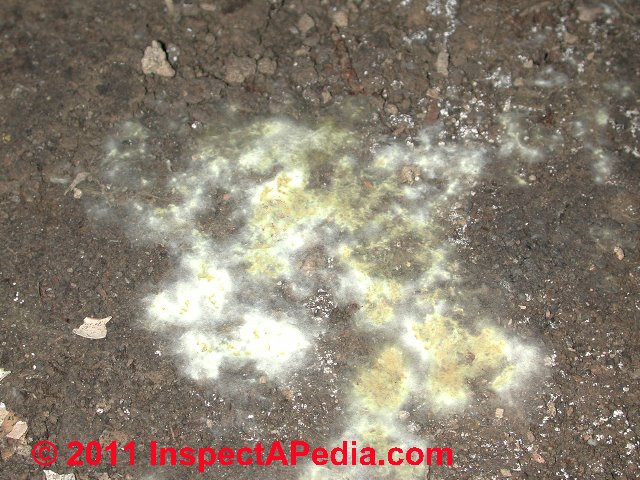
These photographs illustrate mold growth on dirt in a crawl space.
See MOLD & MUSHROOMS INDOORS on DIRT FLOORS
And
see CRAWLSPACE MOLD ADVICE for a guide to correcting a moldy crawl area
Mold on Doors, interior, hollow-core
Below we show mold colonization on a hollow core door we tested in a home where flooding had gone undetected for several months. It is interesting but not really a shock to observe that very different levels and even genera/species of mold might grow on an interior door on different surfaces: the face of the door compared with the edges of the door.
Watch out: the face of a typical hollow core interior door may be a veneer luan or birch, while the door edges are typically solid soft pine.
We suspect that either differences in moisture uptake of the two woods on the different door surfaces, or differences in the wood species, or both, resulted in different levels and types of mold growth.

Below are more examples of mold growth on hollow-core interior doors exposed to high moisture (below left) and extensive leaks from above (below-right).
and extensive mold on water damaged, delaminating plywood:
and more common mold on a painted door:
This photograph illustrates mold growth on a pre-finished hollow core door.
Also see MOLD GROWTH on SURFACES, TABLE OF - which mold genera/species are frequently found on various building surfaces
Mold on Doors, interior, solid wood
Above our photograph illustrates mold growth on a solid interior door - a louvered model.
On the door below there are at least two genera of mold on the solid wood pine door in our photograph.
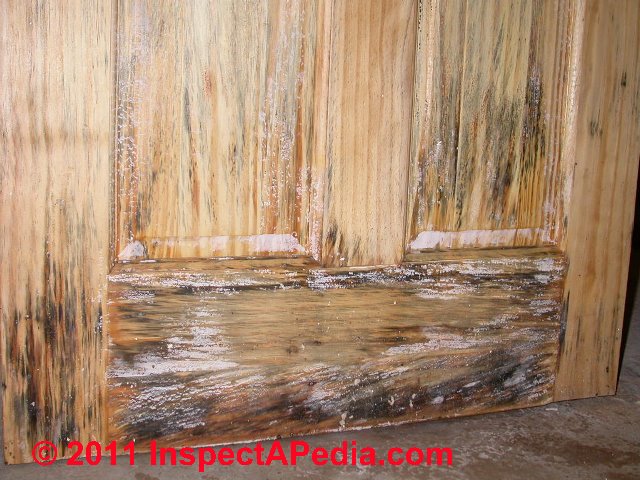
The solid wood and glass French Doors illustrated below were observed in a home where basement flooding occurred due to a heating boiler leak.
Hot water and even steam rose throughout the home and went unattended for more than a week.
The doors above were considered beyond economical cleaning. They were replaced.
Mold on Drywall or Sheetrock®
Black mold in the drywall in a laundry room is shown in our photo at left. On this wall we found that the dominant mold genera were Stachybotrys sp. and Aspergillus sp. though the latter was harder to see.
When inspecting or collecting test samples of "toxic black mold" be alert for and remember to sample other molds of other colors or textures. These molds are sometimes more harmful and more easily airborne mold species.
Details about the growth patterns of different genera/species of molds on drywall as a function of moisture gradient and other conditions, and advice about how and where to collect test samples from moldy drywall are found
at DRYWALL MOLD TESTING.
Mold on the cavity side of drywall was found by making a test cut into a wall where we suspected a history of leaks, even though in this case there was no mold visible on the room side of the drywall.
This toxic black mold, Memnoniella echinata identified in our mold test lab was visible at a small test cut [Image] into the wall cavity in a NY City high rise building.
Water had leaked from an A/C condensate line into the metal track of the metal-stud wall, following the metal sill plate around an extensive distance inside the apartment. .
Larger wall cuts [Image] were made in order to look for hidden mold. Later, extensive demolition [Image] exposed a very large toxic mold colony in this building.
The mold growth pattern on the drywall cavity surface maps the points of contact of the wall insulation kraft paper with the drywall surface.
It is characteristic of wall cavity mold and is different from the growth pattern of mold growing on a freely exposed-to-air drywall surface.
These black mold photos (above) show dense black fungal growth on drywall (black mold on Sheetrock™ type wall surfaces) in areas that had been very wet from chronic leaks or building flooding.
The distinct top edge of mold growth shown in our photographs above are often observed due to a flood water level or even without flooding, the sudden or distinct line where mold growth slows or stops can be due to a discontinuity in the wall material - in this case it was a tape joint in drywall that affected the moisture gradient in the wall and thus the mold growth pattern.
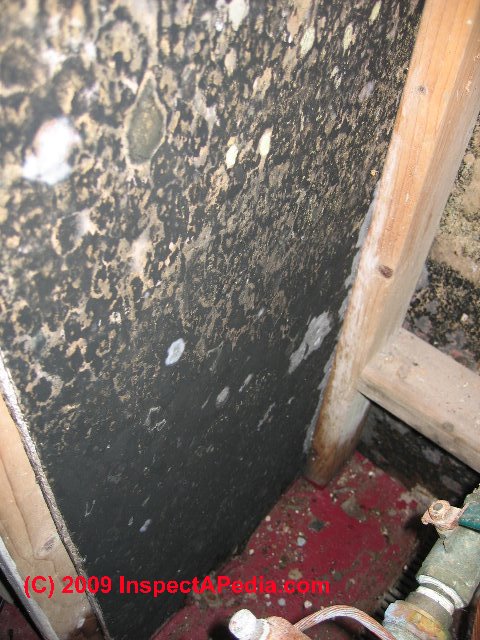
Above we provide a closer look at very thick black mold on the cavity side of drywall found in a wet basement.
Mold growth on drywall and often on other surfaces includes a family of circular growth patterns (upper area of photo above ) until the mold growth has expanded to form a solid black covering
(left wall of photo above and lower wall of black mold in photo below)/
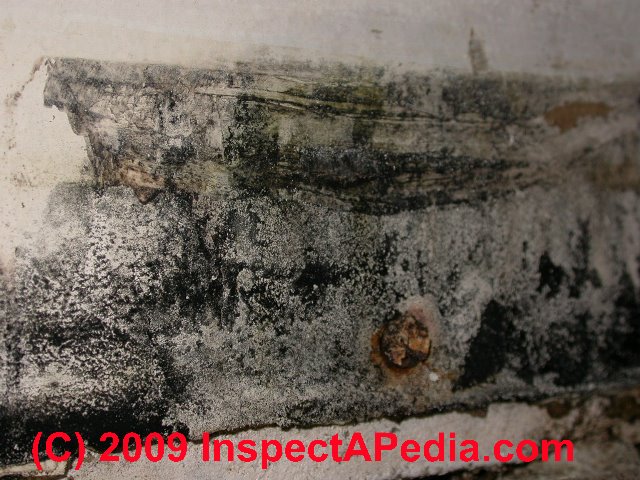
Our photo at above left shows black mold colonies as individual rounded "rings" on the cavity side of drywall on a building crawl area wall.
The black mold photo at right shows how dense black mold may be hidden from view behind wall baseboard trim (removed for this picture) in a building that has suffered wet floors.
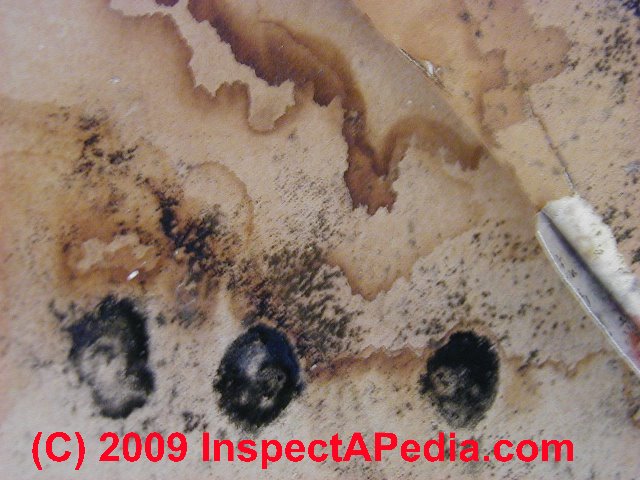
The next two pictures show a closer view of black mold on building surfaces to show what mold colonies look like on close inspection in-situ.
Above is mold on water stained drywall in a basement utility area.
Just above are two small mold colonies that have appeared on a kitchen ceiling in just a few days after a heating system leak led to high indoor moisture and humidity levels.
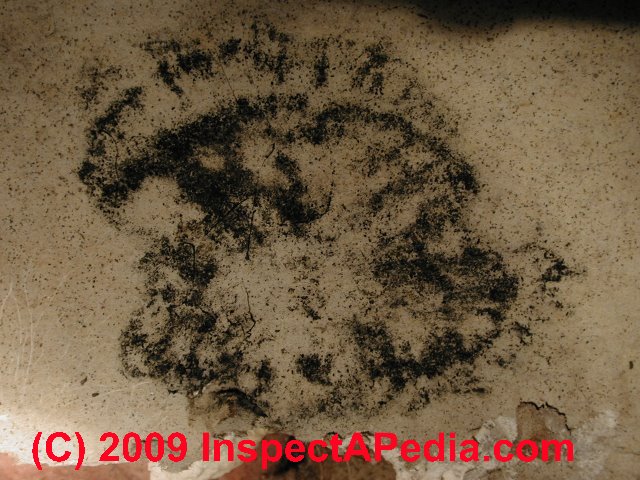
Much more closely we can examine an individual black mold colony on a painted drywall ceiling (above left).
In the microscope at 1000x we can see individual spores of Stachybotrys chartarum - a well known black mold that is often found on indoor building surfaces.
Also see more moldy drywall photos at MOLD on PAINTED DRYWALL
Watch out: except in the most trivial cases, drywall or plasterboard are usually replaced rather than cleaned when their surfaces have become mold contaminated. Surface cleaning is ineffective and it cannot address mold growth on the building-cavity side of a ceiling or wall.
See DRYWALL MOLD TESTING for a detailed exposition on moldy drywall.
CONTACT us to submit photographs of mold growth on other man-made or building-related materials.
...
Continue reading at MOLD GROWTH on SURFACES, PHOTOS_GROUP_5 or select a topic from the closely-related articles below, or see the complete ARTICLE INDEX.
Or see these
Mold Identification Articles
- BLACK MOLD, HARMLESS
- MOLD APPEARANCE on VARIOUS SURFACES index to photos of mold on all kinds of surfaces and materials
- MOLD APPEARANCE - WHAT MOLD LOOKS LIKE - home
- MOLD APPEARANCE - STUFF THAT IS NOT MOLD
- MOLD ATLAS & PARTICLES INDEX
- MOLD FREQUENCY in BUILDINGS
- MOLD in BUILDINGS
- MOLD CONTAMINATION IN BUILDINGS - home
- MOLD by MICROSCOPE - mold under the microscope
- MOLD in the PETRI DISH, PHOTOS - mold on culture plates or in culture-type mold test kits
- MOLD RELATED ILLNESS SYMPTOMS
Suggested citation for this web page
MOLD GROWTH on SURFACES, PHOTOS_GROUP_4 at InspectApedia.com - online encyclopedia of building & environmental inspection, testing, diagnosis, repair, & problem prevention advice.
Or see this
INDEX to RELATED ARTICLES: ARTICLE INDEX to MOLD CONTAMINATION & REMEDIATION
Or use the SEARCH BOX found below to Ask a Question or Search InspectApedia
Ask a Question or Search InspectApedia
Try the search box just below, or if you prefer, post a question or comment in the Comments box below and we will respond promptly.
Search the InspectApedia website
Note: appearance of your Comment below may be delayed: if your comment contains an image, photograph, web link, or text that looks to the software as if it might be a web link, your posting will appear after it has been approved by a moderator. Apologies for the delay.
Only one image can be added per comment but you can post as many comments, and therefore images, as you like.
You will not receive a notification when a response to your question has been posted.
Please bookmark this page to make it easy for you to check back for our response.
IF above you see "Comment Form is loading comments..." then COMMENT BOX - countable.ca / bawkbox.com IS NOT WORKING.
In any case you are welcome to send an email directly to us at InspectApedia.com at editor@inspectApedia.com
We'll reply to you directly. Please help us help you by noting, in your email, the URL of the InspectApedia page where you wanted to comment.
Citations & References
In addition to any citations in the article above, a full list is available on request.
- In addition to citations & references found in this article, see the research citations given at the end of the related articles found at our suggested
CONTINUE READING or RECOMMENDED ARTICLES.
- Carson, Dunlop & Associates Ltd., 120 Carlton Street Suite 407, Toronto ON M5A 4K2. Tel: (416) 964-9415 1-800-268-7070 Email: info@carsondunlop.com. Alan Carson is a past president of ASHI, the American Society of Home Inspectors.
Thanks to Alan Carson and Bob Dunlop, for permission for InspectAPedia to use text excerpts from The HOME REFERENCE BOOK - the Encyclopedia of Homes and to use illustrations from The ILLUSTRATED HOME .
Carson Dunlop Associates provides extensive home inspection education and report writing material. In gratitude we provide links to tsome Carson Dunlop Associates products and services.


